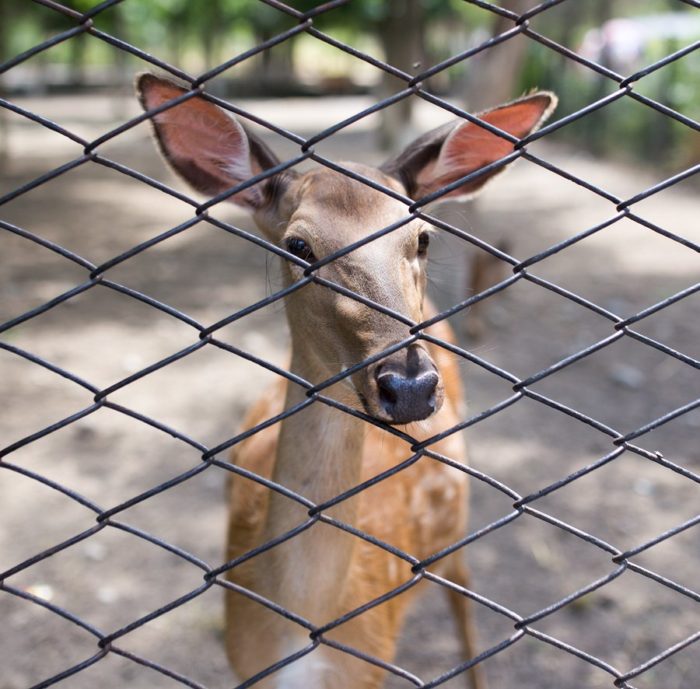The recent discovery of Chronic Wasting Disease in a wild deer just a half-mile from a Merrifield deer farm has amplified discussions among hunters, deer farmers, wildlife officials and state legislators about what steps Minnesota should take to address the always-fatal illness.
CWD was documented in captive deer at the farm, which the owner chose not to depopulate. Wildlife experts were not surprised when the disease was discovered in a wild deer nearby. They believe that CWD outbreaks in the wild result from exposure to the disease due to contact with infected deer and elk in farming operations. They also believe CWD has been spread across much of North America by the movement of captive deer among farming operations and shooting preserves. While all of the above is disputed by the deer farming industry, Minnesota hunting organizations and others are calling upon the Legislature to place new restrictions on deer and elk farms by requiring double fencing, prohibiting the movement of animals, prohibiting new operations and launching a voluntary buy-out program for existing farms.
These are big, bold steps for the traditionally ag-friendly Legislature, but the possible social and economic consequences of doing nothing at all are chilling. Minnesota has roughly half a million deer hunters who have a $500 million impact on the economy. Agencies such as the World Health Organization warn against eating CWD-contaminated venison, due to the possible risk of the disease “crossing the species barrier” to humans. While that is not believed to have yet occurred, a similar illness, Mad Cow Disease, crossed from cattle to people in Great Britain during the 1980s. If CWD begins to spread in Minnesota’s wild deer, interest in hunting them could take serious downturn.
Tightening restrictions on deer and elk farms may not be politically easy, but Minnesota is not the first state to follow this path. In the late 1990s, following failed legislative attempts to restrict game farms, a handful of Montana conservationists launched a ballot initiative to accomplish their goal. Dave Stalling of Missoula, who was president of the Montana Wildlife Federation at the time, said surveys showed about 70 percent of Montanans were opposed to game farms. What the conservationists lacked in political strength, they made up for with public support.
At the time, CWD was just beginning to gain steam, including one case at a Montana farm, but there were other game farm-related issues. In 1991, game farm elk shipped from Montana to Alberta led to an outbreak of bovine tuberculosis, which eventually infected livestock, other animals and even people. Alberta also lost its TB-free status, a costly blow for the province and its livestock industry. In 1995, 15 game farm elk escaped in the wild.
But the issue that rang sour with both hunters and nonhunters was “hunting” big game inside fenced enclosures. Hunters see game farm “hunts” as an affront to the principles of fair chase. Non hunters just find it offensive. To avoid criticism from game farm advocates that the ballot initiative was antihunting, Stalling said his group did not solicit donations from out-of-state organizations, such as the Humane Society of the United States.
They were supported by Montana conservation organizations, including the Missoula-based Rocky Mountain Elk Foundation. They also received favorable press coverage in the state. A catchy slogan, Keep Elk Wild and Free, Support I-143, brought the message to the public. The movement gained momentum—and stubborn resistance.
Opponents said Stalling and the other leaders of the initiative were antihunters and that shutting down game farms was the first down a slippery slope to ban all hunting.
“That was easy to counter,” Stalling said, “because all of us were hunters.”
The second criticism caught the attention of Montana landowners, many of whom are ranchers and farmers. Game farm advocates said that ordering the closure of game farms was a “takings” of private property rights. Some livestock producers agreed with this argument, while others worried about the potential of disease transmission from farmed elk and deer to domestic livestock. The ballot initiative supporters countered by pointing out that there was plenty of legal precedence showing that a property owner does not have an absolute right to use their property in a way that negatively affects others beyond the property line. A common example is that we don’t allow strip clubs next door to elementary schools.
When disagreeing with their opponents, Stalling said the initiative supporters worked to maintain their integrity by making sure their information was correct and backed up by science. And the science clearly shows that elk and deer in close confinement have a greater risk of disease than free-ranging animals.
“We had a lot of science on our side,” he said.
They also used common sense. They made sure the initiative did not affect traditional ranch operations, a mainstay of the rural Montana. The only animals covered by the initiative were big game—elk, deer, bears, bighorn sheep and mountain goats. Bison, which were not classified as big game, were not included, nor were animals such as llamas and emus. The initiative was tightly focused on the species likely to have adverse effects on wild game.
Under the initiative, new game farms were prohibited. Existing operations could stay in business, but were prohibited from transferring their license to another party or allowing other parties to shoot game farm animals for a fee. Existing game farms were allowed to move animals.
When it was put before Montana voters, I-143 was narrowly passed. Supporters declared victory, but they were wounded and battle-scarred.
“When the initiative ended, I was really beat up” Stalling said. “We had 13 lawsuits against us. We also received death threats and threats to our families.”
In the end, everything came out all right and no one was hurt. Today, Montana has about 25 remaining game farms, Minnesota, in comparison, has about 400. Montana has discovered wild deer with CWD, but the disease appears to be creeping in from neighboring Wyoming and Alberta, where it is endemic. In contrast, CWD’s appearance in Minnesota appears to be associated with contaminated game farms.
Minnesota doesn’t have a ballot initiative option. In order to change a law, the citizens of this state must get the new law passed by the Minnesota Legislature. Unfortunately, politicians serving in the Legislature don’t always listen to the people who elected them, especially regarding management and protection of the state’s natural resources. Minnesota has nearly a half million deer hunters, not to mention many more folks who appreciate whitetails and a healthy natural landscape. Placing new restrictions on game farms in order to limit the spread of CWD and protect the state’s wild deer, moose and elk has broad public support. If legislative history is any indication, politicians may not act to do so, instead preserving the status quo to benefit a relative handful of game farm operations; Minnesota’s wildlife and hunting heritage be damned.
That’s not the way it should be. But in Minnesota politics, too often that’s the way it is.




